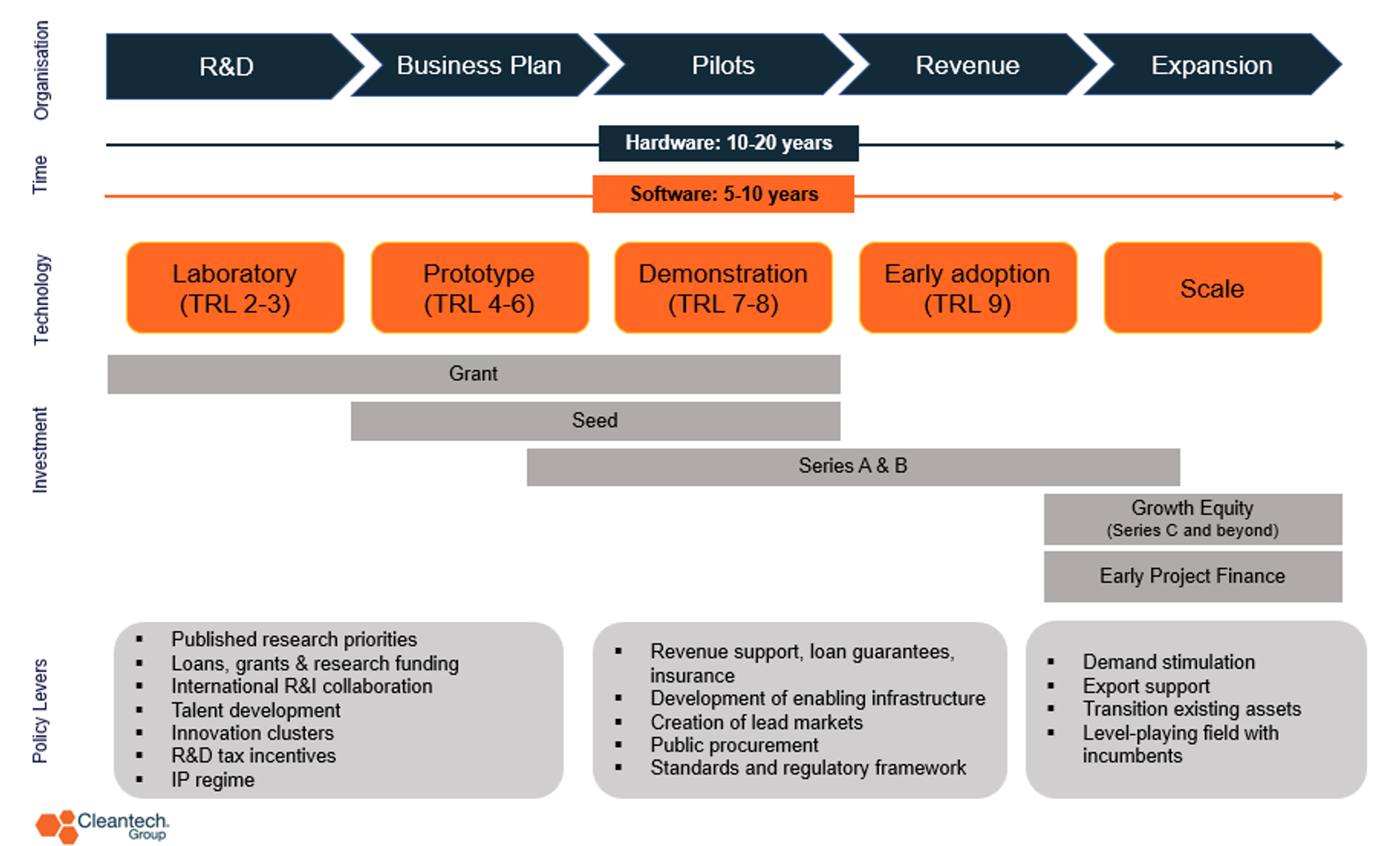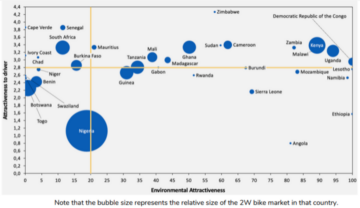There is often debate as to the role government should play in supporting emerging businesses. Should public bodies intervene to back innovative companies, or are these businesses best left to develop themselves in the private sector?
Since market dynamics in the cleantech space often favor incumbent technologies over less-polluting alternatives, public support is needed to help those new, disruptive technologies reach mass adoption. The most successful cleantech ecosystems are targeting support to the areas where it will have greatest impact, ensuring resources are used in the most effective way.
Cleantech Group’s work has found that there are a series of policy levers across the innovation lifecycle that can accelerate the path of new technologies to the scale required for climate impact and economic growth. The tools used by governments are most effective when they are adapted to the stage of a particular company or technology.
This blog will share some real-world examples of successful public intervention mechanisms that governments can implement in the following stages and show how they should be prioritized:
- Early-stage innovation
- Demonstration and commercialization
- Scaling and internationalization
Cleantech Group’s Policy Levers by Lifecycle Stage framework helps guide governments on the most effective policy tools to use at each stage of technology development.
Policy Levers by Lifecycle Stage

Early-Stage Innovation
Early-stage innovation encompasses R&D and laboratory work to spinouts, all the way to prototype creation. Early-stage grants and research funding, in which governments provide direct financial support to back the development of new and promising technologies, allow emerging innovators to engage in technically uncertain but potentially breakthrough product development that would be too risky for private sector investors. Public grants and research funding may also act as a quality signal to the private market to help crowd in subsequent investment.
Cleantech for UK found that public grant money helps attract future private investment, as government support can indicate credibility to private investors. Similar studies done on the U.S. Department of Energy’s (DoE) R&D grant program found that grant-winning companies had higher probabilities of receiving VC funding, as well as positive impacts on revenues and patents. Other countries that have had success through grant programs include Denmark, who developed their offshore wind industry in large part due to government capital grants, and Israel, where Innovation Israel has supported over 250 cleantech start-ups.
Other tools that support early-stage innovation include international research collaboration (as used by the island nation Mauritius to bring in scientific knowledge from abroad, the Singapore-Australia Go-Green Co-Innovation Programme to collaborate on innovative cleantech R&D, and the EU’s Directorate-General Research & Innovation that develops the bloc’s research policy), as well as talent attraction and development programs to drive innovation and growth in key sectors.
Demonstration and Commercialization
After developing the science and prototype, innovators begin to demonstrate their product under real-world conditions. At this stage, grants become less effective, as funding needs increase and become more complex – especially for hardware companies. Catalytic capital comprises a set of targeted financing mechanisms to de-risk first commercial projects, including (but not limited to) loan guarantees, first-loss capital, and insurances.
Canada’s Export Development Agency (EDC) is an example of a government agency that uses guarantees to great effect. EDC’s Export Guarantee Program guarantees 75% – 100% of a loan of up to $10M with a Canadian financial institution, allowing companies to access credit that commercial banks would have otherwise deemed too risky. EDC’s use of catalytic capital has supported over 300 cleantech companies and CAD $20B in cleantech export business over the past 11 years, attesting to the power catalytic capital tools can have in unlocking cleantech investment. Other successful examples of de-risking tools include the UK’s Contract for Difference (CfD) scheme, as well as the U.S. DoE’s Loan Program.
Green public procurement is another effective tool for government to boost cleantech at this critical stage of development, especially as a first customer. Advanced market commitments from governments can mitigate market risk for emerging technologies by showing there is a willingness to pay for novel cleantech solutions, while providing a revenue stream to innovators to reduce their dependence on external financing. An example of this in cleantech can be seen in Germany’s commitment to purchase electricity from renewable sources, which is considered instrumental in driving the growth of solar energy market.
Scaling and Internationalization
Once a company’s product is commercially demonstrated, they start the final step of their business journey: scaling. This stage is all about improving innovators’ access to global markets so they can scale their solution beyond the local environment. Our work with UNIDO’s Global Cleantech Innovation Program taught us that one of the most impactful ways governments can support local cleantech champions and local cleantech industries is through international partnerships. These partnerships can take many forms. Export partnership is deployed by the Japanese External Trade Organization (JETRO) to help Japanese start-ups scale and internationalize. JETRO helps innovators to maximize their global export potential and engages international investors who can bring both investment and international market opportunities to local start-ups. Export partnerships are also leveraged by Israeli and Finnish innovation agencies.
Another example is knowledge partnerships, which Chile’s government has used to help develop industrial capabilities. Many observers see Chile as a raw materials powerhouse, as they have the largest reserves of copper and lithium in the world, two key minerals for many clean technologies. However, Chile wants to capitalize on its natural resources to produce higher value-added products locally and is developing plans to attract industrial capabilities from China and the EU. By collaborating with foreign companies that already possess specialized knowledge, the Chilean government hopes to increase domestic innovation, upskill its workforce, and enhance economic growth.
Prioritization
Not all countries have the same financial capacity or resources available to equally implement the activities described above, so how can policy makers best prioritize which tools to use? As a first step, it is important to identify country-specific climate risks, analyse how these risks might affect different socioeconomic sectors, and establish clear priorities that emphasize the government’s commitment to addressing climate change and supporting cleantech solutions.
These long-term policy signals are critical to motivating action from the private sector and other stakeholders. For example, Finland’s and China’s respective innovation agencies – which have both had ample success in supporting cleantech growth in recent years – produce five-year plans to send stable, long-term policy signals to the innovation ecosystem. In contrast, countries like the UK, whose government plans operate on 3-year cycles, have been criticized by stakeholders for not providing the certainty needed-to-encourage private sector engagement.
For countries at the beginning of their climate journey, following the order of the innovation lifecycle is a good point of reference. It is important to first target interventions towards early-stage innovation to ensure there is a strong pipeline of research and potential technologies; investing in demonstration or commercialization activities without a preexisting baseline of early-stage cleantech would yield much less impact. Once a sufficient early-stage innovation is developed, a country can move on to supporting the development and commercialization of clean technologies, and finally, to scaling and internationalization.
Government Support Important
Governments have a wide range of tools at their disposal to support cleantech companies and industries throughout the business lifecycle. This blog gives only a few examples of the tools and policies available and shows that there is an important role for governments to play in supporting cleantech at each stage of the business lifecycle.
- SEO Powered Content & PR Distribution. Get Amplified Today.
- PlatoData.Network Vertical Generative Ai. Empower Yourself. Access Here.
- PlatoAiStream. Web3 Intelligence. Knowledge Amplified. Access Here.
- PlatoESG. Carbon, CleanTech, Energy, Environment, Solar, Waste Management. Access Here.
- PlatoHealth. Biotech and Clinical Trials Intelligence. Access Here.
- Source: https://www.cleantech.com/the-role-of-public-support-in-accelerating-cleantech-innovation/
- :has
- :is
- :not
- :where
- $UP
- 11
- 250
- 300
- a
- About
- above
- abroad
- accelerate
- accelerating
- access
- across
- Act
- Action
- activities
- adapted
- addressing
- Adoption
- advanced
- affect
- agencies
- agency
- All
- allow
- Allowing
- already
- also
- alternatives
- an
- analyse
- and
- Another
- ARE
- areas
- AS
- At
- attract
- attraction
- available
- back
- Banks
- Baseline
- BE
- become
- been
- begin
- Beginning
- BEST
- Beyond
- Blog
- bodies
- boost
- both
- breakthrough
- bring
- business
- businesses
- but
- by
- CAD
- CAN
- Canadian
- capabilities
- Capacity
- capital
- capitalize
- certainty
- Champions
- change
- Chile
- China
- Chinas
- clean
- cleantech
- clear
- Climate
- Climate change
- collaborate
- collaborating
- commercial
- commercialization
- commercially
- commitment
- commitments
- Companies
- company
- Company’s
- comprises
- conditions
- considered
- contract
- contrast
- countries
- country
- country-specific
- creation
- Credibility
- credit
- critical
- criticized
- crowd
- cycles
- debate
- deemed
- demonstrate
- demonstrated
- demonstration
- Denmark
- Department
- dependence
- deployed
- described
- develop
- developed
- developing
- Development
- develops
- difference
- different
- direct
- disposal
- disruptive
- DOE
- Domestic
- done
- drive
- driving
- due
- dynamics
- each
- early stage
- Economic
- Economic growth
- ecosystem
- Ecosystems
- effect
- Effective
- electricity
- emerging
- emerging technologies
- emphasize
- encompasses
- energy
- engage
- engagement
- engages
- enhance
- ensure
- ensuring
- Environment
- equally
- especially
- establish
- Ether (ETH)
- EU
- example
- examples
- export
- external
- favor
- few
- final
- Finally
- financial
- financial institution
- financing
- Finnish
- First
- following
- For
- foreign
- forms
- found
- Framework
- from
- funding
- future
- gives
- Global
- global markets
- Go
- good
- Government
- government support
- Governments
- grant
- grant programs
- grants
- great
- greatest
- Group
- Group’s
- Growth
- guarantee
- guarantees
- guide
- had
- Hardware
- Have
- help
- helps
- High
- higher
- hopes
- How
- However
- HTML
- HTTPS
- identify
- Impact
- impactful
- Impacts
- implement
- important
- improving
- in
- include
- Including
- Increase
- Incumbent
- indicate
- industrial
- industries
- industry
- Innovation
- innovative
- innovators
- Institution
- instrumental
- International
- international investors
- intervene
- intervention
- interventions
- investing
- investment
- Investors
- island
- Israel
- Israeli
- IT
- ITS
- Japanese
- journey
- Key
- knowledge
- laboratory
- large
- largest
- left
- less
- leveraged
- lifecycle
- like
- Limited
- loan
- local
- locally
- long-term
- Makers
- many
- Market
- market opportunities
- Markets
- Mass
- Mass Adoption
- materials
- max-width
- Maximize
- May..
- mechanisms
- might
- minerals
- Mitigate
- money
- more
- most
- motivating
- move
- much
- nation
- Natural
- needed
- needs
- New
- New technologies
- novel
- observers
- of
- often
- on
- once
- ONE
- only
- operate
- opportunities
- or
- order
- organization
- Other
- otherwise
- our
- over
- part
- particular
- partnerships
- past
- path
- Pay
- pipeline
- plans
- plato
- Plato Data Intelligence
- PlatoData
- Play
- Point
- policies
- policy
- Policy Makers
- positive
- possess
- potential
- potentially
- power
- powerhouse
- Prioritize
- prioritized
- private
- private sector
- probabilities
- procurement
- produce
- Product
- product development
- Products
- Program
- programme
- Programs
- projects
- promising
- prototype
- provide
- providing
- public
- purchase
- quality
- R&D
- range
- Raw
- reach
- real world
- receiving
- recent
- reduce
- reference
- Renewable
- required
- research
- reserves
- Resources
- respective
- revenue
- revenues
- Risk
- risks
- Risky
- Role
- s
- same
- Scale
- scaling
- scheme
- Science
- scientific
- sector
- Sectors
- see
- seen
- send
- Series
- set
- Share
- should
- show
- showing
- Shows
- Signal
- signals
- similar
- So
- socioeconomic
- solar
- solar energy
- solution
- Solutions
- some
- Sources
- Space
- specialized
- stable
- Stage
- stages
- stakeholders
- start
- start-ups
- Step
- stream
- strong
- studies
- subsequent
- success
- successful
- sufficient
- support
- Supported
- Supporting
- Take
- Target
- targeted
- targeting
- taught
- technically
- Technologies
- Technology
- Technology Development
- that
- The
- the UK
- the world
- their
- themselves
- There.
- These
- they
- this
- those
- Through
- throughout
- to
- too
- tool
- tools
- towards
- trade
- two
- u.s.
- Uk
- Uncertain
- under
- unlocking
- us
- use
- used
- uses
- VC
- VC funding
- wants
- Way..
- ways
- WELL
- when
- which
- while
- WHO
- whose
- wide
- Wide range
- will
- Willingness
- wind
- with
- without
- Work
- Workforce
- world
- would
- years
- Yield
- zephyrnet










